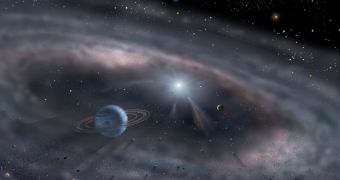As you have probably noticed in the last few days, planetary formation and new solar system study is getting a lot of attention lately. Especially when talking about organic molecules, water and habitable zones, all of these being considered important factors in the apparition of life. Researchers announce that water vapors have been found in the accretion disk of matter spinning around not one, but two young stars. Both have great chances to form new planets around them.
The stars in question are DR Tau and As 205 A, located 457 light years, respectively 391 light years, away from Earth. Graduate student in geological and planetary science at Caltech, Coletter Salyk says that "This is one of the very few times that water vapor has been detected in the inner part of a protoplanetary disk - the most likely place for terrestrial planets to form."
Detection
With the help of NASA's Spitzer Infrared Space Observatory, Caltech researchers revealed that the disk of matter orbiting the two stars presents spikes of bright material, corresponding to the wavelengths of water. Without Spitzer's Infrared eye, researchers would be unable to make such detections. Further still, ground observations in the infrared wavelengths of the electromagnetic spectrum are basically impossible because of the high concentrations of vapor water in Earth's atmosphere, which would interfere with the signals coming from these particular solar systems.
Nonetheless, the data collected by Spitzer needed to be correlated to that of the Keck II Telescope in Hawaii, to make detailed measurements related to the speed and location of the water vapor molecules. "They were moving at fast speeds, indicating that they came from close to the stars, which is where Earth-like planets might be forming," said Salyk.
Although the finding is extremely important for planet formation study, the results indicate that the amount of water currently present in the matter disk is barely comparable to that of the water in the oceans here on Earth. Albeit only a small part of the disk is actually visible, it points towards greater amounts of water throughout the volume of the disk.
Planets take shape
According to professor of cosmochemistry and planetary sciences Geoffrey Black from Caltech, the presence of water could also represent strong evidence that planets are forming around these two stars. The model of our own solar system suggests that, during the formation of Jupiter, its gravitational pull gathered most of the icy bodies in the outer regions of the disk of matter, but for this to happen some of these icy bodies would have first needed to travel closer to the central star to evaporate and create similar water vapors as observed in the two systems.
"Our observations are possible evidence for the migration of solids in the disk", said Salyk. Another participant in the study, Klaus Pontoppidan argues that "It will take years of work to understand the details of what we see. We were surprised at how easy it is to find water in planet-forming disks once we had learned where to look."

 14 DAY TRIAL //
14 DAY TRIAL //